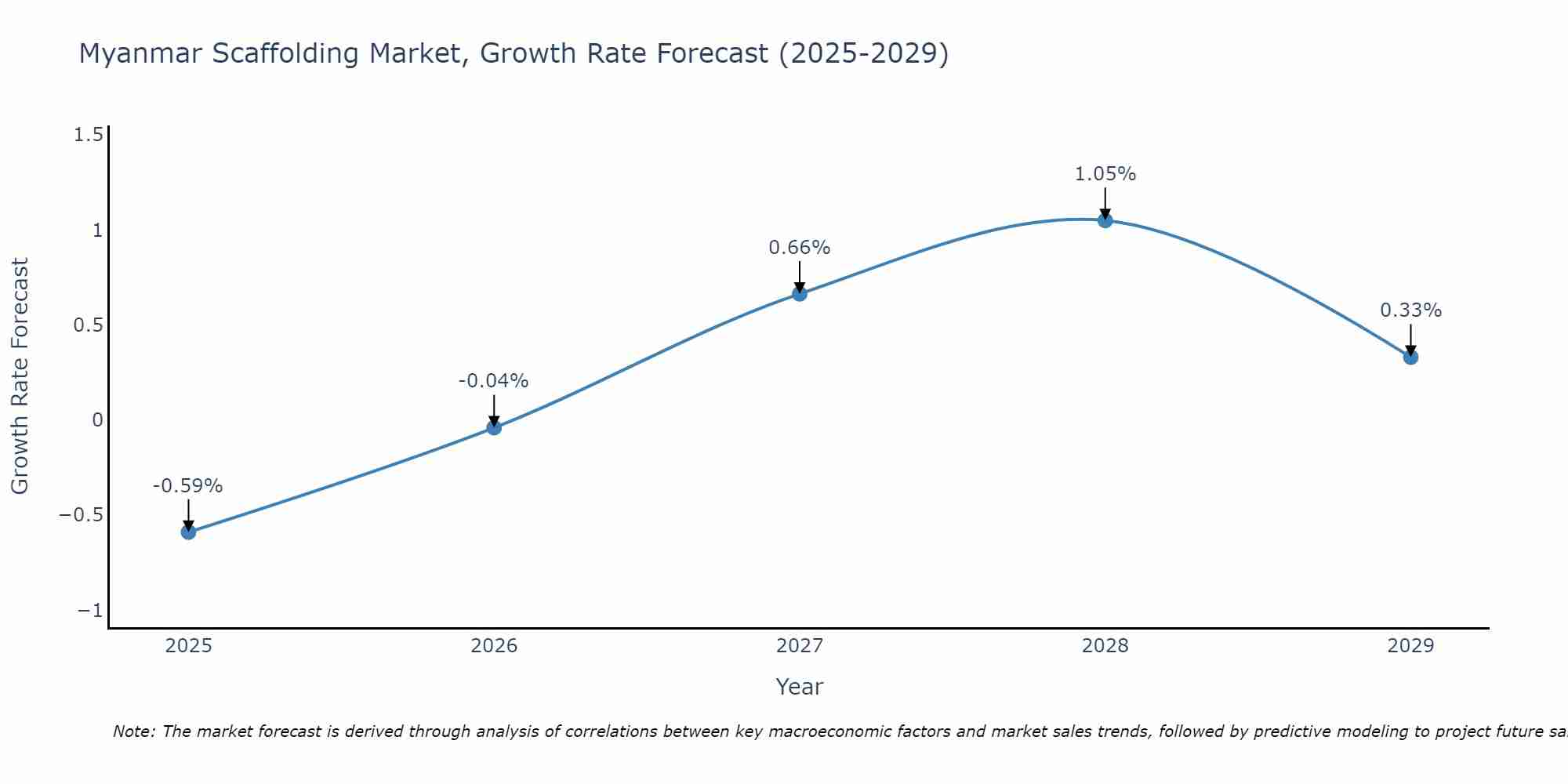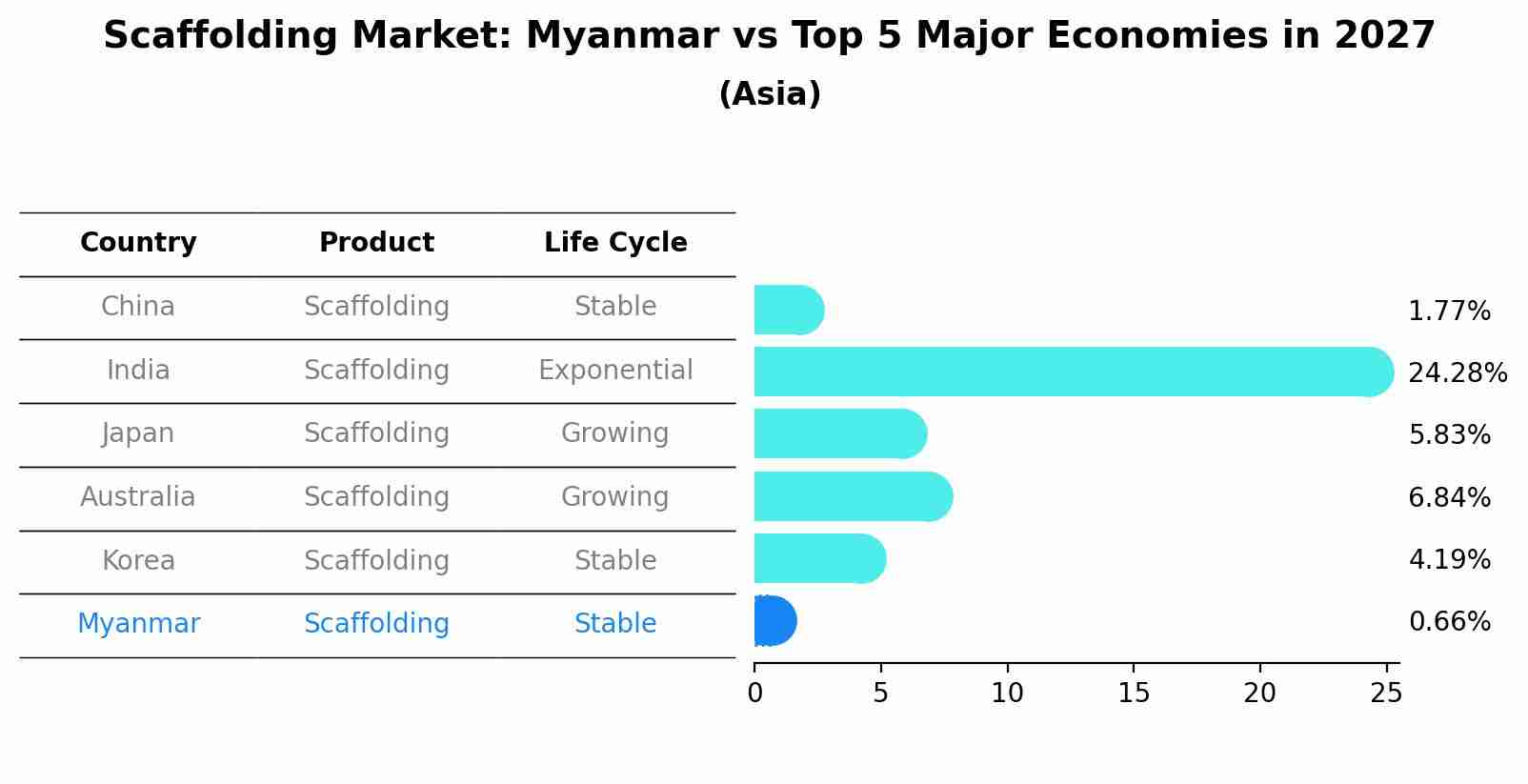Myanmar Scaffolding Market Outlook | COVID-19 IMPACT, Size, Industry, Growth, Companies, Value, Share, Forecast, Trends, Revenue & Analysis
| Product Code: ETC377794 | Publication Date: Aug 2022 | Updated Date: Jul 2025 | Product Type: Market Research Report | |
| Publisher: 6Wresearch | Author: Shubham Deep | No. of Pages: 75 | No. of Figures: 35 | No. of Tables: 20 |
Myanmar Scaffolding Market Size Growth Rate
The Myanmar Scaffolding Market is projected to witness mixed growth rate patterns during 2025 to 2029. Starting at -0.59% in 2025, the market peaks at 1.05% in 2028, and settles at 0.33% by 2029.

Scaffolding Market: Myanmar vs Top 5 Major Economies in 2027 (Asia)
By 2027, Myanmar's Scaffolding market is forecasted to achieve a stable growth rate of 0.66%, with China leading the Asia region, followed by India, Japan, Australia and South Korea.

Myanmar Scaffolding Market Synopsis
The Myanmar scaffolding market is characterized by steady growth driven by increasing construction activities in sectors such as infrastructure, real estate, and industrial projects. The market is primarily dominated by steel and aluminum scaffolding due to their durability and flexibility in various construction applications. Factors such as government initiatives to boost infrastructure development, rising urbanization, and foreign investments in the construction sector are fueling the demand for scaffolding in Myanmar. Key players in the market are focusing on product innovation, strategic partnerships, and expanding their distribution networks to gain a competitive edge. However, challenges such as lack of skilled labor, safety concerns, and fluctuating raw material prices are impacting the market growth to some extent. Overall, the Myanmar scaffolding market is poised for further expansion in the coming years.
Myanmar Scaffolding Market Trends
The Myanmar scaffolding market is witnessing a growing demand for lightweight and easy-to-assemble scaffolding solutions, driven by the increasing construction activities in the country. Aluminum and fiberglass scaffolding systems are gaining popularity due to their durability, corrosion resistance, and ease of transportation. Safety regulations and standards are also playing a crucial role in shaping the market, with a greater emphasis on ensuring the well-being of workers at construction sites. Additionally, the trend towards sustainable and environmentally-friendly construction practices is driving the adoption of eco-friendly scaffolding materials. As the construction industry in Myanmar continues to expand, the scaffolding market is expected to evolve further with innovative solutions to meet the changing needs of the sector.
Myanmar Scaffolding Market Challenges
In the Myanmar scaffolding market, challenges include a lack of standardized regulations and safety guidelines, leading to potential safety hazards at construction sites. Additionally, limited access to high-quality materials and skilled labor can affect the overall efficiency and quality of scaffold installations. Political instability and changes in government regulations also create uncertainties for market players, impacting investment decisions and long-term planning. Inadequate infrastructure and transportation networks further hinder the distribution of scaffolding equipment to remote or rural areas, limiting market growth potential. Addressing these challenges through improved regulations, investment in training programs, and infrastructure development will be crucial for the sustainable growth of the scaffolding market in Myanmar.
Myanmar Scaffolding Market Investment Opportunities
The Myanmar scaffolding market offers promising investment opportunities due to the country`s growing construction industry driven by infrastructure development and urbanization. With increasing demand for high-rise buildings, industrial facilities, and infrastructure projects, the need for safe and efficient scaffolding solutions is on the rise. Potential investment opportunities in the Myanmar scaffolding market include supplying innovative and high-quality scaffolding materials and systems, offering rental services to construction companies, or investing in scaffolding manufacturing facilities to cater to the local market. Additionally, providing training and safety services related to scaffolding usage could also be a lucrative investment avenue as the construction sector in Myanmar continues to expand. Overall, investing in the scaffolding market in Myanmar presents a chance to capitalize on the country`s construction boom and establish a strong presence in this growing sector.
Jordan Agar Market Government Policies
The government policies related to the Myanmar scaffolding market aim to regulate safety standards and promote sustainable growth within the industry. The Ministry of Construction oversees the implementation of guidelines and regulations to ensure the safety of workers and the quality of construction projects using scaffolding. Companies operating in the market are required to adhere to these standards to obtain permits and licenses for their projects. Additionally, the government encourages the use of eco-friendly and sustainable materials in scaffolding construction to minimize environmental impact. Overall, the government`s policies in Myanmar`s scaffolding market focus on promoting safety, quality, and sustainability to support the growth of the construction industry.
Myanmar Scaffolding Market Future Outlook
The Myanmar scaffolding market is poised for significant growth in the coming years, driven by increasing construction activities across various sectors such as residential, commercial, and industrial. The growing urbanization, infrastructure development projects, and foreign investments are expected to fuel the demand for scaffolding solutions in the country. Additionally, the government`s initiatives to improve regulations and standards in the construction industry are likely to boost the adoption of advanced scaffolding technologies. With a favorable economic environment and a rising demand for high-quality and safe construction practices, the Myanmar scaffolding market is anticipated to experience steady expansion and offer lucrative opportunities for market players in the foreseeable future.
Key Highlights of the Report:
- Myanmar Scaffolding Market Outlook
- Market Size of Myanmar Scaffolding Market, 2021
- Forecast of Myanmar Scaffolding Market, 2031
- Historical Data and Forecast of Myanmar Scaffolding Revenues & Volume for the Period 2018 - 2031
- Myanmar Scaffolding Market Trend Evolution
- Myanmar Scaffolding Market Drivers and Challenges
- Myanmar Scaffolding Price Trends
- Myanmar Scaffolding Porter's Five Forces
- Myanmar Scaffolding Industry Life Cycle
- Historical Data and Forecast of Myanmar Scaffolding Market Revenues & Volume By Type for the Period 2018 - 2031
- Historical Data and Forecast of Myanmar Scaffolding Market Revenues & Volume By Supported Scaffolding for the Period 2018 - 2031
- Historical Data and Forecast of Myanmar Scaffolding Market Revenues & Volume By Suspended Scaffolding for the Period 2018 - 2031
- Historical Data and Forecast of Myanmar Scaffolding Market Revenues & Volume By Rolling Scaffolding for the Period 2018 - 2031
- Historical Data and Forecast of Myanmar Scaffolding Market Revenues & Volume By Material for the Period 2018 - 2031
- Historical Data and Forecast of Myanmar Scaffolding Market Revenues & Volume By Aluminum for the Period 2018 - 2031
- Historical Data and Forecast of Myanmar Scaffolding Market Revenues & Volume By Wood for the Period 2018 - 2031
- Historical Data and Forecast of Myanmar Scaffolding Market Revenues & Volume By Steel for the Period 2018 - 2031
- Historical Data and Forecast of Myanmar Scaffolding Market Revenues & Volume By End User for the Period 2018 - 2031
- Historical Data and Forecast of Myanmar Scaffolding Market Revenues & Volume By Residential for the Period 2018 - 2031
- Historical Data and Forecast of Myanmar Scaffolding Market Revenues & Volume By Commercial for the Period 2018 - 2031
- Historical Data and Forecast of Myanmar Scaffolding Market Revenues & Volume By Industrial for the Period 2018 - 2031
- Myanmar Scaffolding Import Export Trade Statistics
- Market Opportunity Assessment By Type
- Market Opportunity Assessment By Material
- Market Opportunity Assessment By End User
- Myanmar Scaffolding Top Companies Market Share
- Myanmar Scaffolding Competitive Benchmarking By Technical and Operational Parameters
- Myanmar Scaffolding Company Profiles
- Myanmar Scaffolding Key Strategic Recommendations
Frequently Asked Questions About the Market Study (FAQs):
- Single User License$ 1,995
- Department License$ 2,400
- Site License$ 3,120
- Global License$ 3,795
Search
Thought Leadership and Analyst Meet
Our Clients
Related Reports
- Canada Oil and Gas Market (2026-2032) | Share, Segmentation, Value, Industry, Trends, Forecast, Analysis, Size & Revenue, Growth, Competitive Landscape, Outlook, Companies
- Germany Breakfast Food Market (2026-2032) | Industry, Share, Growth, Size, Companies, Value, Analysis, Revenue, Trends, Forecast & Outlook
- Australia Briquette Market (2025-2031) | Growth, Size, Revenue, Forecast, Analysis, Trends, Value, Share, Industry & Companies
- Vietnam System Integrator Market (2025-2031) | Size, Companies, Analysis, Industry, Value, Forecast, Growth, Trends, Revenue & Share
- ASEAN and Thailand Brain Health Supplements Market (2025-2031) | Strategy, Consumer Insights, Analysis, Investment Trends, Opportunities, Growth, Size, Share, Industry, Revenue, Segments, Value, Segmentation, Supply, Forecast, Restraints, Outlook, Competition, Drivers, Trends, Demand, Pricing Analysis, Competitive, Strategic Insights, Companies, Challenges
- ASEAN Bearings Market (2025-2031) | Strategy, Consumer Insights, Analysis, Investment Trends, Opportunities, Growth, Size, Share, Industry, Revenue, Segments, Value, Segmentation, Supply, Forecast, Restraints, Outlook, Competition, Drivers, Trends, Demand, Pricing Analysis, Competitive, Strategic Insights, Companies, Challenges
- Europe Flooring Market (2025-2031) | Outlook, Share, Industry, Trends, Forecast, Companies, Revenue, Size, Analysis, Growth & Value
- Saudi Arabia Manlift Market (2025-2031) | Outlook, Size, Growth, Trends, Companies, Industry, Revenue, Value, Share, Forecast & Analysis
- Uganda Excavator, Crane, and Wheel Loaders Market (2025-2031) | Strategy, Consumer Insights, Analysis, Investment Trends, Opportunities, Growth, Size, Share, Industry, Revenue, Segments, Value, Segmentation, Supply, Forecast, Restraints, Outlook, Competition, Drivers, Trends, Demand, Pricing Analysis, Competitive, Strategic Insights, Companies, Challenges
- Rwanda Excavator, Crane, and Wheel Loaders Market (2025-2031) | Strategy, Consumer Insights, Analysis, Investment Trends, Opportunities, Growth, Size, Share, Industry, Revenue, Segments, Value, Segmentation, Supply, Forecast, Restraints, Outlook, Competition, Drivers, Trends, Demand, Pricing Analysis, Competitive, Strategic Insights, Companies, Challenges
Industry Events and Analyst Meet
Whitepaper
- Middle East & Africa Commercial Security Market Click here to view more.
- Middle East & Africa Fire Safety Systems & Equipment Market Click here to view more.
- GCC Drone Market Click here to view more.
- Middle East Lighting Fixture Market Click here to view more.
- GCC Physical & Perimeter Security Market Click here to view more.
6WResearch In News
- Doha a strategic location for EV manufacturing hub: IPA Qatar
- Demand for luxury TVs surging in the GCC, says Samsung
- Empowering Growth: The Thriving Journey of Bangladesh’s Cable Industry
- Demand for luxury TVs surging in the GCC, says Samsung
- Video call with a traditional healer? Once unthinkable, it’s now common in South Africa
- Intelligent Buildings To Smooth GCC’s Path To Net Zero


















